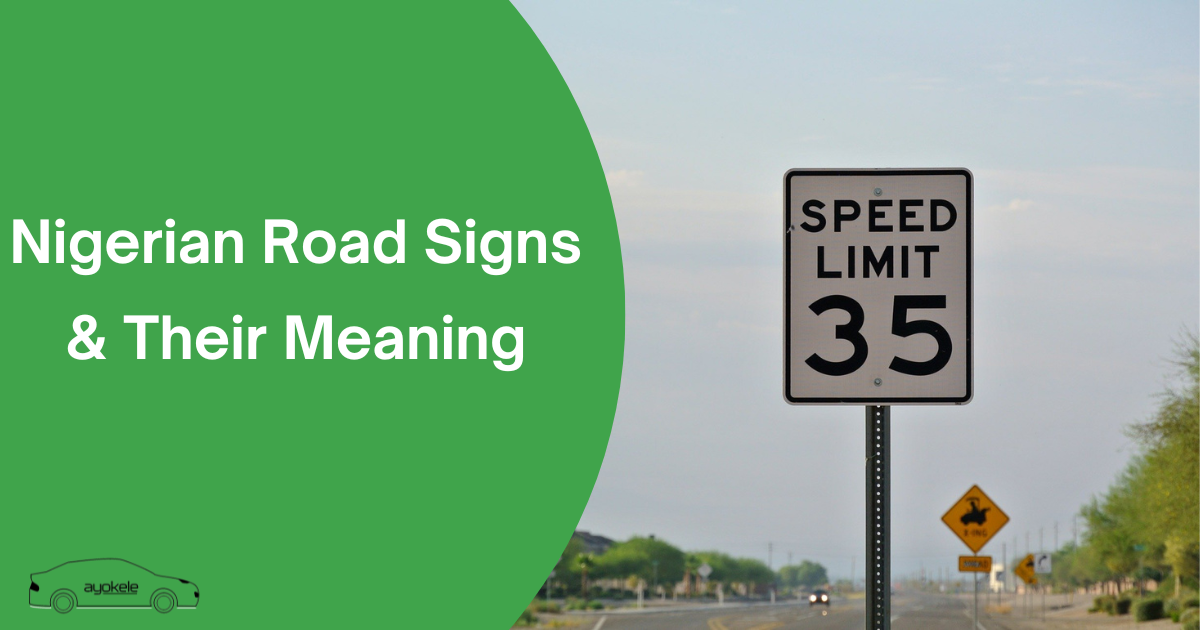Road signs are essential for safe and orderly movement on the roads. They provide instructions, warnings, and information to drivers, motorcyclists, cyclists, and pedestrians. In Nigeria, road signs are standardized and regulated by the Federal Road Safety Corps (FRSC) and are similar to those used in many other countries. Understanding these signs is crucial for anyone who wants to drive safely and avoid penalties.
Nigerian road signs are generally grouped into three main categories: regulatory signs, warning signs, and informative (guide) signs. Below is a comprehensive list of common Nigerian road signs and their meanings.
1. Regulatory Signs
Regulatory signs are used to indicate rules and regulations that must be obeyed. Disobeying these signs is an offense.
A. Prohibitory Signs (Red Circle or Red Slash)
- No Entry: Vehicles are not allowed to enter.
- No U-Turn: Making a U-turn is not allowed.
- No Left Turn: Left turns are prohibited.
- No Right Turn: Right turns are prohibited.
- No Overtaking: Overtaking is not allowed.
- No Parking: Parking is not allowed at this spot.
- No Stopping: Stopping is not allowed at this spot.
- No Horn: Use of horn is not allowed.
- Speed Limit: Maximum speed allowed (e.g., 50 km/h).
- Weight Limit: Vehicles above a certain weight are not allowed.
- No Motorcycles: Motorcycles are not allowed.
- No Bicycles: Bicycles are not allowed.
- No Pedestrians: Pedestrians are not allowed.
B. Mandatory Signs (Blue Circle)
- Turn Left Only: You must turn left.
- Turn Right Only: You must turn right.
- Go Straight Only: You must go straight.
- Keep Left: Keep to the left side of the road.
- Keep Right: Keep to the right side of the road.
- Roundabout: You must follow the roundabout direction.
- Minimum Speed: You must not drive below the indicated speed.
2. Warning Signs
Warning signs, usually triangular with a red border, alert road users to potential hazards or changes in road conditions ahead.
- Sharp Bend Left/Right: There is a sharp bend ahead in the direction shown.
- Double Bend: Two bends in quick succession.
- Steep Hill Upwards/Downwards: Steep slope ahead.
- Slippery Road: The road ahead may be slippery.
- Narrow Bridge: The bridge ahead is narrow.
- Road Narrows: The road ahead becomes narrower.
- Pedestrian Crossing: Pedestrians may be crossing ahead.
- Children Crossing: Children may be crossing ahead (often near schools).
- Animal Crossing: Animals may be crossing the road.
- Traffic Signals Ahead: Traffic lights ahead.
- Roundabout Ahead: A roundabout is ahead.
- Crossroads: Intersection ahead.
- T-Junction: T-shaped intersection ahead.
- Y-Junction: Y-shaped intersection ahead.
- Railway Crossing (With/Without Gate): Railway tracks ahead, may or may not have a gate.
- Bumps Ahead: Speed bumps or humps ahead.
- Falling Rocks: Beware of falling rocks.
- Two-Way Traffic: Road changes from one-way to two-way traffic.
- Merging Traffic: Another road joins from the side.
- Divided Road Ends: Dual carriageway ends ahead.
3. Informative (Guide) Signs
Informative or guide signs provide useful information to help road users navigate and find services.
- Hospital: Hospital or medical facility nearby.
- Police Station: Police station nearby.
- Fuel Station: Petrol or fuel station ahead.
- Parking: Designated parking area.
- Bus Stop: Bus stop ahead.
- Rest Area: Place to rest or refresh.
- Direction Signs: Indicate directions to towns, cities, or landmarks.
- Distance Signs: Show distance to destinations.
- Airport: Airport ahead.
- Ferry: Ferry crossing ahead.
- Hotel/Lodging: Accommodation available ahead.
- Toilets: Public toilets available.
- Telephone: Public telephone available.
4. Road Markings
Road markings are also important signs painted on the road surface.
- Single Continuous Line: Do not cross or overtake.
- Double Continuous Line: Absolutely no crossing or overtaking.
- Broken Line: Overtaking is allowed if safe.
- Zebra Crossing: Pedestrian crossing area.
- Arrows: Indicate direction of travel or lane use.
- Stop Line: Where vehicles must stop at junctions or signals.
5. Traffic Light Signals
- Red Light: Stop.
- Yellow/Amber Light: Prepare to stop.
- Green Light: Go if the way is clear.
Knowing and obeying road signs is essential for safe driving and helps prevent accidents and fines. Whether you are preparing for a driving test or just want to refresh your knowledge, understanding these signs and their meanings will make you a safer and more confident road user. Always pay attention to road signs—they are there to guide and protect everyone on the road.




